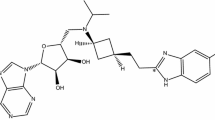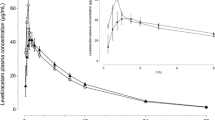Abstract
Background and Objective
Cenobamate is an antiepileptic drug for the treatment of partial-onset seizures. The current study was designed to assess the mass balance and the metabolic profiling of cenobamate in humans.
Methods
Absorption, metabolism, and excretion of cenobamate were investigated in healthy male subjects after a single oral dose of 400 mg of cenobamate containing 50 µCi of [14C]-cenobamate as capsule formulation.
Results
Cenobamate was rapidly (median time to maximum plasma concentration of 1.25 h) and extensively (≥ 88% of dose) absorbed. The mean cenobamate plasma concentration–time profile revealed a multiphasic elimination profile whereas the mean plasma/blood concentration–time curve for total radioactivity did not appear to be multiphasic, suggesting that elimination mechanisms for cenobamate and its metabolites may be different. Blood/plasma ratios observed for the area under the concentration–time curve (AUC) and peak concentration (both ~ 0.60) suggest a limited penetration of cenobamate and metabolites into red blood cells (RBCs). Eight cenobamate metabolites were identified across plasma, urine, and feces. Cenobamate was the main plasma radioactive component and M1 was the only metabolite detected in plasma (> 98% and < 2% total radioactivity AUC, respectively). All detected metabolites were found in urine, with M1 as the major radioactive component (mean cumulative recovery 37.7% of dose); unchanged cenobamate accounted for 6%. Metabolites comprised ~ 88% of the dose recovered in urine, indicating extensive metabolism by the kidneys and/or metabolites formed in the liver were rapidly eliminated from the bloodstream. However, cenobamate metabolites appear to be formed slowly. Minor amounts of cenobamate (0.48%) and five metabolites (≤ 1.75% each; M1, M3, M6, M7, M11) were recovered in feces.
Conclusion
This study indicates that cenobamate is primarily eliminated in urine as metabolites. Cenobamate is the major circulating component in plasma after oral administration and has a limited penetration into RBCs.




Similar content being viewed by others
References
Patsalos PN, Perucca E. Clinically important drug interactions in epilepsy: interactions between antiepileptic drugs and other drugs. Lancet Neurol. 2003;2:473–81.
Perucca E. Clinically relevant drug interactions with antiepileptic drugs. Br J Clin Pharmacol. 2006;61:246–55.
Johannessen Landmark C, Patsalos PN. Drug interactions involving the new second- and third-generation antiepileptic drugs. Expert Rev Neurother. 2010;10:119–40.
XCOPRI® (cenobamate tablets), for oral use [prescribing information]. Paramus, NJ: SK Life Science, Inc.; 2019.
Nakamura M, Cho JH, Shin HS, Jang IS. Effects of cenobamate (YKP3089), a newly developed anti-epileptic drug, on voltage-gated sodium channels in rat hippocampal CA3 neurons. Eur J Pharmacol. 2019;855:175–82.
Sharma R, Song WS, Nakamura M, et al. Effects of cenobamate on GABA-A receptor modulation [abstract]. American Epilepsy Society Annual Meeting, November 30–December 4, 2018, New Orleans, LA; Abstract 3.306.
Vernillet L, Greene SA, Kamin M. Pharmacokinetics of cenobamate: results from single and multiple oral ascending dose studies in healthy subjects. Clin Pharmacol Drug Dev. 2020. https://doi.org/10.1002/cpdd.769.
Knights KM, Rowland A, Miners JO. Renal drug metabolism in humans: the potential for drug-endobiotic interactions involving cytochrome P450 (CYP) and UDP-glucuronosyltransferase (UGT). Br J Clin Pharmacol. 2013;76:587–602.
Acknowledgements
The authors would like to thank Staci J. McDonald, PharmD, Robert A. Earl, PhD, Ian Malloch Davis, MS, Elliot Offman, BSc Pharm, MSc, S. James Lee, PhD, Martin Brecher, MD, Palanichamy Ilankumaran, PhD and Zhaoping Yan, for study contribution. Additionally, the authors thank the staff and volunteers who participated in this study. The authors also thank Debika Chatterjea, PhD, MedVal Scientific Information Services, LLC for providing medical writing support, which was funded by SK Life Science, Inc. This manuscript was prepared according to the International Society for Medical Publication Professionals’ “Good Publication Practice for Communicating Company-Sponsored Medical Research: The GPP3 Guidelines.”
Author information
Authors and Affiliations
Corresponding author
Ethics declarations
Funding
This study was funded by SK Life Science, Inc.
Conflict of Interest
LV, employee of SK Life Science, Inc.; SAG, employee of SK Life Science, Inc.; HWK, employee of SK Life Science, Inc.; SMM, employee of SK Life Science, Inc.; KG, employee of SK Life Science, Inc.
Data Availability Statement
The authors confirm that the data supporting the main findings of this study are available within the article [and/or] its supplementary materials. Any additional data, noted as ‘data on file’ within the text, are available from the corresponding author [LV] upon reasonable request.
Ethical Approval
This research was conducted in accordance with the clinical research guidelines established by the Medical Research Council of Canada, the Basic Principles defined in U.S. 21 CFR Part 312.20, the requirements of Directive 2001/20/EC (Europe), the principles enunciated in the Declaration of Helsinki and the ICH-harmonised tripartite guideline regarding Good Clinical Practice (GCP). The study was approved by the independent MDS Pharma Services Institutional Review Board.
Informed Consent
Informed consent was given by all subjects who participated in the study.
Previous Presentation
This data was previously presented at the 12th International Society for the Study of Xenobiotics Meeting, July 28–July 31, 2019.
Electronic supplementary material
Below is the link to the electronic supplementary material.
Rights and permissions
About this article
Cite this article
Vernillet, L., Greene, S.A., Kim, H.W. et al. Mass Balance, Metabolism, and Excretion of Cenobamate, a New Antiepileptic Drug, After a Single Oral Administration in Healthy Male Subjects. Eur J Drug Metab Pharmacokinet 45, 513–522 (2020). https://doi.org/10.1007/s13318-020-00615-7
Published:
Issue Date:
DOI: https://doi.org/10.1007/s13318-020-00615-7




